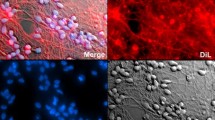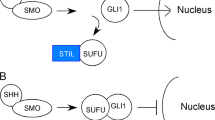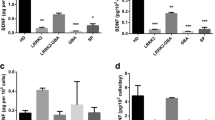Abstract
Two key principles underlying successful cellular therapies for Parkinson’s disease (PD) are appropriate differentiation of dopaminergic (DA) neurons from transplanted cells and precise axon growth. EphrinAs, a subclass of ephrins, act as axon guidance molecules and are highly expressed in DA brain regions. Existing evidences indicate that they act as either repulsion or attraction signals to guide axon growth. This study investigated whether ephrinAs are involved in DA neuron differentiation. Data from miRCURY™ LNA mRNAs/microRNAs microarrays and quantitative real-time polymerase chain reaction (qRT-PCR) showed upregulated ephrinA3 mRNA (EFNA3) and downregulated ephrinA5 mRNA (EFNA5) during DA neuron differentiation. In addition, hsa-miR-4271 was downregulated, which could influence EFNA3 translation. Furthermore, immunofluorescence (IF) and western blotting confirmed the mRNA results and showed increased ephrinA3 and decreased ephrinA5 protein levels in differentiating DA neurons. Taken together, our results indicate that inverse expression levels of ephrinA3 and ephrinA5, which are possibly influenced by microRNAs, contribute to DA neuron differentiation by guiding axon growth.







Similar content being viewed by others
References
Aschrafi A, Schwechter AD, Mameza MG, Natera-Naranjo O, Gioio AE, Kaplan BB (2008) MicroRNA-338 regulates local cytochrome c oxidase IV mRNA levels and oxidative phosphorylation in the axons of sympathetic neurons. J Neurosci 28:12581–12590
Bartel DP (2009) MicroRNAs target recognition and regulatory functions. Cell 136:215–233
Bové J, Prou D, Perier C, Przedborski S (2005) Toxin-induced models of Parkinson’s disease. NeuroRx 2:484–494
Brownlee H, Gao PP, Frisén J, Dreyfus C, Zhou R, Black IB (2000) Multiple ephrins regulate hippocampal neurite outgrowth. J Comp Neurol 425:315–322
Bu L, Li R, Liu H, et al. (2014) Intrastriatal transplantation of retinal pigment epithelial cells for the treatment of Parkinson disease: in vivo longitudinal molecular imaging with 18F-P3BZA PET/CT. Radiology 272:174–183
Bush JO, Soriano P (2012) Eph/ephrin signaling: genetic, phosphoproteomic, and transcriptomic approaches. Semin Cell Dev Biol 23:26–34
Cang J, Wang L, Stryker MP, Feldheim DA (2008) Roles of ephrin-as and structured activity in the development of functional maps in the superior colliculus. J Neurosci 28:11015–11023
Carmona MA, Murai KK, Wang L, Roberts AJ, Pasquale EB (2009) Glial ephrin-A3 regulates hippocampal dendritic spine morphology and glutamate transport. Proc Natl Acad Sci U S A 106:12524–12529
Cheng H-J, Nakamoto M, Bergemann AD, Flanagan JG (1995) Complementary gradients in expression and binding of ELF-1 and Mek4 in development of the topographic retinotectal projection map. Cell 82:371–381
Cowan CA, Henkemeyer M (2002) Ephrins in reverse, park and drive. Trends Cell Biol 12:339–346
Cutforth T, Moring L, Mendelsohn M, et al. (2003) Axonal ephrin-as and odorant receptors: coordinate determination of the olfactory sensory map. Cell 114:311–322
Dajas-Bailador F, Bonev B, Garcez P, Stanley P, Guillemot F, Papalopulu N (2012) microRNA-9 regulates axon extension and branching by targeting Map1b in mouse cortical neurons. Nat Neurosci 15:697–699
Davy A, Robbins SM (2000) Ephrin-A5 modulates cell adhesion and morphology in an integrin-dependent manner. EMBO J 19:5396–5405
Davy A, Soriano P (2005) Ephrin signaling in vivo: look both ways. Dev Dyn 232:1–10
Deumens R, Blokland A, Prickaerts J (2002) Modeling Parkinson’s disease in rats: an evaluation of 6-OHDA lesions of the nigrostriatal pathway. Exp Neurol 175:303–317
Drescher U, Kremoser C, Handwerker C, Loschinger J, Noda M, Bonhoeffer F (1995) In vitro guidance of retinal ganglion cell axons by RAGS, a 25 kDa tectal protein related to ligands for Eph receptor tyrosine kinases. Cell 82:359–370
Dufour A, Seibt J, Passante L, et al. (2003) Area specificity and topography of thalamocortical projections are controlled by ephrin/Eph genes. Neuron 39:453–465
Feldheim DA, Kim YI, Bergemann AD, Frisén J, Barbacid M, Flanagan JG (2000) Genetic analysis of ephrin-A2 and ephrin-A5 shows their requirement in multiple aspects of retinocollicular mapping. Neuron 25:563–574
Flanagan JG (2006) Neural map specification by gradients. Curr Opin Neurobiol 16:59–66
Flanagan JG, Vanderhaeghen P (1998) The ephrins and Eph receptors in neural development. Annu Rev Neurosci 21:309–345
Frisén J, Yates PA, McLaughlin T, Friedman GC, O’Leary DD, Barbacid M (1998) Ephrin-A5 (AL-1/RAGS) is essential for proper retinal axon guidance and topographic mapping in the mammalian visual system. Neuron 20:235–243
Grealish S, Xie L, Kelly M, Dowd E (2008) Unilateral axonal or terminal injection of 6-hydroxydopamine causes rapid-onset nigrostriatal degeneration and contralateral motor impairments in the rat. Brain Res Bull 77:312–319
Grunwald IC, Korte M, Adelmann G, et al. (2004) Hippocampal plasticity requires postsynaptic ephrinBs. Nat Neurosci 7:33–40
Hattori M, Osterfield M, Flanagan JG (2000) Regulated cleavage of a contact-mediated axon repellent. Science 289:1360–1365
Hengst U, Cox LJ, Macosko EZ, Jaffrey SR (2006) Functional and selective RNA interference in developing axons and growth cones. J Neurosci 26:5727–5732
Heuer A, Lelos MJ, Kelly CM, Torres EM, Dunnett SB (2013) Dopamine-rich grafts alleviate deficits in contralateral response space induced by extensive dopamine depletion in rats. Exp Neurol 247:485–495
Himanen JP, Rajashankar KR, Lackmann M, Cowan CA, Henkemeyer M, Nikolov DB (2001) Crystal structure of an Eph receptor-ephrin complex. Nature 414:933–938
Holmberg J, Frisén J (2002) Ephrins are not only unattractive. Trends Neurosci 25:239–243
Holmberg J, Clarke DL, Frisén J (2000) Regulation of repulsion versus adhesion by different splice forms of an Eph receptor. Nature 408:203–206
Kiessling F (2014) Science to practice: cellular therapy of Parkinson disease—a new radiotracer to target transplanted dopaminergic cells with PET. Radiology 272:1–3
Kim VN (2005) MicroRNA biogenesis: coordinated cropping and dicing. Nat Rev Mol Cell Biol 6:376–385
Knoll B, Drescher U (2002) Ephrin-as as receptors in topographic projections. Trends Neurosci 25:145–149
Knoll B, Zarbalis K, Wurst W, Drescher U (2001) A role for the EphA family in the topographic targeting of vomeronasal axons. Development 128:895–906
Krol J, Loedige I, Filipowicz W (2010) The widespread regulation of microRNA biogenesis, function and decay. Nat Rev Genet 11:597–610
Liu K, Lu Y, Lee JK, et al. (2010) PTEN deletion enhances the regenerative ability of adult corticospinal neurons. Nat Neurosci 13:1075–1081
Marquardt T, Shirasaki R, Ghosh S, et al. (2005) Coexpressed EphA receptors and ephrin-a ligands mediate opposing actions on growth cone navigation from distinct membrane domains. Cell 121:127–139
Martinez A, Soriano E (2005) Functions of ephrin/Eph interactions in the development of the nervous system: emphasis on the hippocampal system. Brain Res Brain Res Rev 49:211–226
McLaughlin T, Hindges R, O’Leary DD (2003) Regulation of axial patterning of the retina and its topographic mapping in the brain. Curr Opin Neurobiol 13:57–69
Müller J, Ossig C, Greiner JF, et al. (2015) Intrastriatal transplantation of adult human neural crest-derived stem cells improves functional outcome in parkinsonian rats. Stem Cells Transl Med 4:31–43
Murai KK, Nguyen LN, Irie F, Yamaguchi Y, Pasquale EB (2003) Control of hippocampal dendritic spine morphology through ephrin-A3/EphA4 signaling. Nat Neurosci 6:153–160
Natera-Naranjo O, Aschrafi A, Gioio AE, Kaplan BB (2010) Identification and quantitative analyses of microRNAs located in the distal axons of sympathetic neurons. RNA 16:1516–1529
Pittman A, Chien CB (2002) Understanding dorsoventral topography: backwards and forwards. Neuron 35:409–411
Remy P (2014) Biotherapies for Parkinson disease. Rev Neurol (Paris) 170:763–769
Rhee YH, Ko JY, Chang MY, et al. (2011) Protein-based human iPS cells efficiently generate functional dopamine neurons and can treat a rat model of Parkinson disease. J Clin Invest 121:2326–2335
Schratt G (2009) microRNAs at the synapse. Nat Rev Neurosci 10:842–849
Seiradake E, Schaupp A, del Toro RD, et al. (2013) Structurally encoded intraclass differences in EphA clusters drive distinct cell responses. Nat Struct Mol Biol 20:958–964
Shin ES, Hwang O, Hwang YS, Suh JK, Chun YI, Jeon SR (2014) Enhanced efficacy of human brain-derived neural stem cells by transplantation of cell aggregates in a rat model of Parkinson’s disease. J Korean Neurosurg Soc 56:383–389
Stein E, Savaskan NE, Ninnemann O, Nitsch R, Zhou R, Skutella T (1999) A role for the Eph ligand ephrin-A3 in entorhino-hippocampal axon targeting. J Neurosci 19:8885–8893
Vanderhaeghen P, Lu Q, Prakash N, et al. (2000) A mapping label required for normal scale of body representation in the cortex. Nat Neurosci 3:358–365
Vo N, Klein ME, Varlamova O, et al. (2005) A cAMP-response element binding protein-induced microRNA regulates neuronal morphogenesis. Proc Natl Acad Sci U S A 102:16426–16431
Wahl S, Barth H, Ciossek T, Aktories K, Mueller BK (2000) Ephrin-A5 induces collapse of growth cones by activating rho and rho kinase. J Cell Biol 149:263–270
Wang HU, Anderson DJ (1997) Eph family transmembrane ligands can mediate repulsive guidance of trunk neural crest migration and motor axon outgrowth. Neuron 18:383–396
Wilkinson DG (2001) Multiple roles of EPH receptors and ephrins in neural development. Nat Rev Neurosci 2:155–164
Xu B, Li S, Brown A, Gerlai R, Fahnestock M, Racine RJ (2003) EphA/ephrin-a interactions regulate epileptogenesis and activity-dependent axonal sprouting in adult rats. Mol Cell Neurosci 24:984–999
Yu JY, Chung KH, Deo M, Thompson RC, Turner DL (2008) MicroRNA miR-124 regulates neurite outgrowth during neuronal differentiation. Exp Cell Res 314:2618–2633
Yue X, Dreyfus C, Kong TA, Zhou R (2008) A subset of signal transduction pathways is required for hippocampal growth cone collapse induced by ephrin-A5. Dev Neurobiol 68:1269–1286
Author information
Authors and Affiliations
Corresponding author
Ethics declarations
Conflict of Interest
The authors declare that they have no competing interests.
Additional information
Ting Wang and Jing Chen contributed equally to this article.
Rights and permissions
About this article
Cite this article
Wang, T., Chen, J., Tang, CX. et al. Inverse Expression Levels of EphrinA3 and EphrinA5 Contribute to Dopaminergic Differentiation of Human SH-SY5Y Cells. J Mol Neurosci 59, 483–492 (2016). https://doi.org/10.1007/s12031-016-0759-y
Received:
Accepted:
Published:
Issue Date:
DOI: https://doi.org/10.1007/s12031-016-0759-y




